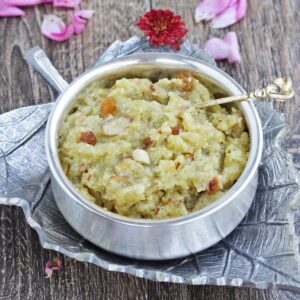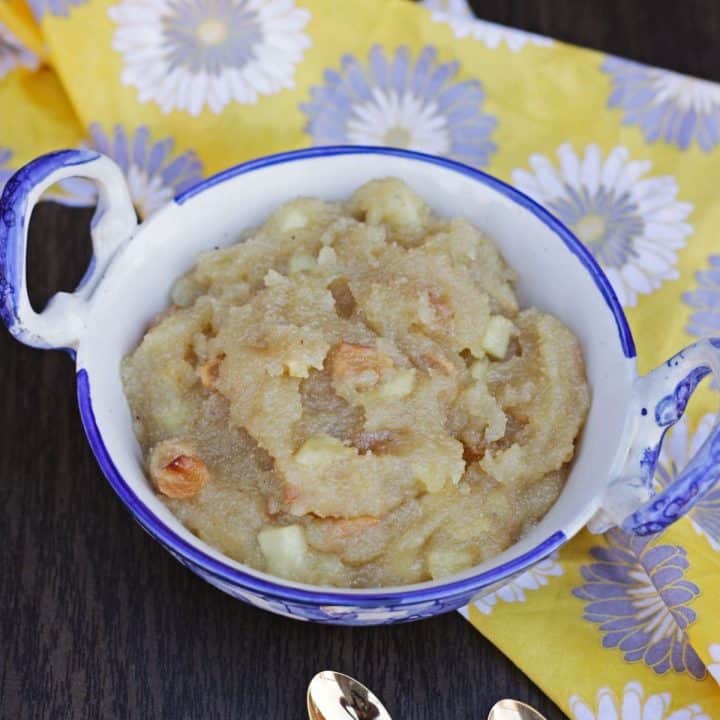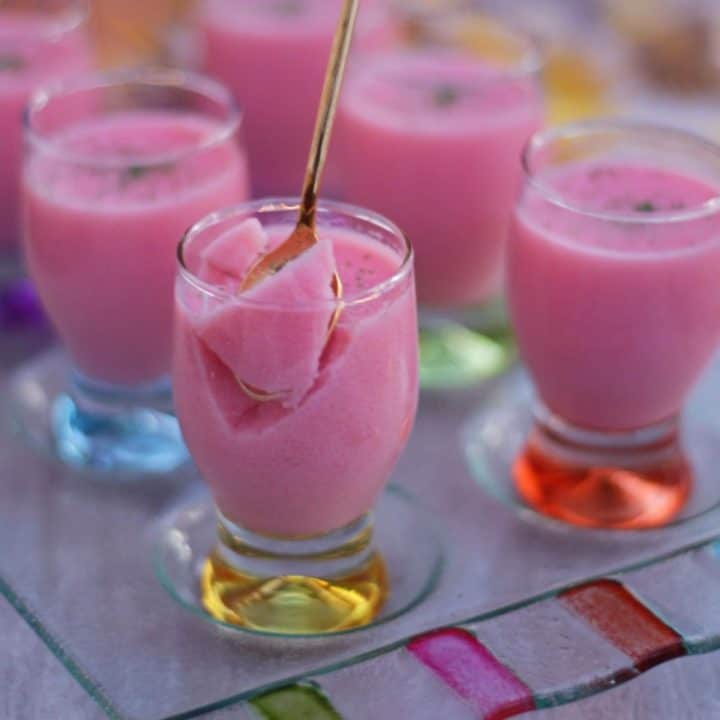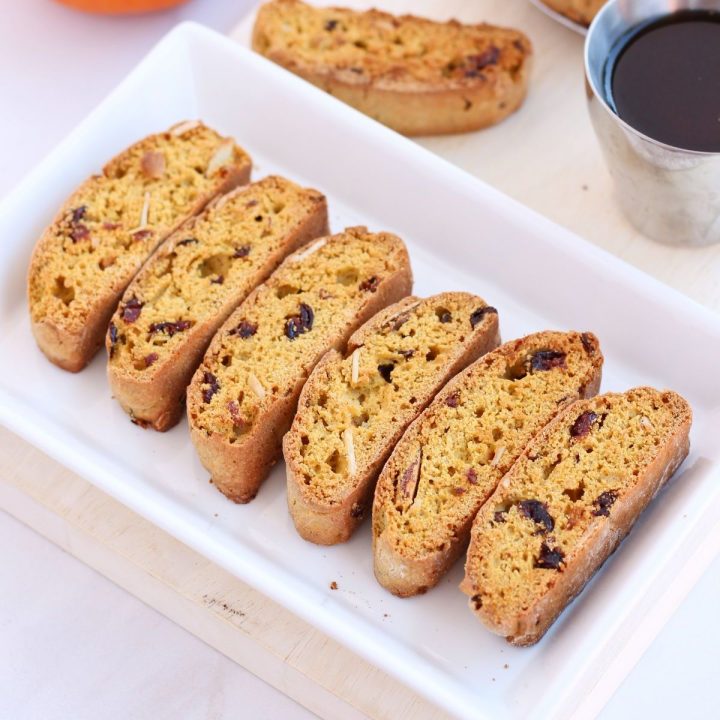Halwa is an essential part of Indian dessert menu and this Lauki Halwa made with bottle gourd, sugar, milk and Khoa (milk solids) is very delicious and a great use of the vegetable harvested from the backyard.

Lot of Indian Halwa recipes are made with vegetables. I have had many ask me, a dessert made with vegetable?
Absolutely!!
There is Carrot Halwa which happens to be a global favorite and a very popular dessert recipe. This Lauki Halwa, also known as Dudhi / Doodhi halwa is very similar to carrot halwa.
As carrot halwa is to North Indian cuisine, there are South Indian favorites as well. White pumpkin halwa / Kasi halwa which happens to be my husband's favorite ever, is made with ash gourd.
Summer is our favorite time as we get loads of vegetables from our backyard garden. This year has been extraordinarily good for bottle gourd and we have been harvesting a couple every week.
I knew that I wanted to make Lauki ka halwa after our first harvest. My friend had brought us some dudhi halwa she had made and my husband loved it. So I almost followed the flavor of her halwa. The store-bought Lauki ka halwa is green in color as that is a color they add to it. I used saffron for flavor and color and hence mine has a beautiful golden hue.

Ingredients Needed
Bottle Gourd - We need a tender bottle gourd to make this halwa. Taste a little bit of your lauki before cooking to make sure that they don't taste bitter.
Sugar - The quantity of sugar depends on how sweet you want your halwa to be. I made mine moderately sweet and that is the measurement I will be adding. I have used granulated white sugar but can be made with brown sugar as well.
Milk and Milk Solid (Khoa) - I have used both milk and khoya in my recipe. If you want to skip the khoya, use more milk. Check my FAQ section below for more tips on how to get the best flavor from the milk and Khoya.
Dry Fruits - I used sliced almonds, chopped cashews, and raisins. We could also add a little pistachio.
Other Ingredients - We need ghee to make halwa. Since we are cooking the halwa in milk, we don't need too much ghee for this recipe. I used saffron threads and cardamom for flavor and to give color to the halwa.
Step By Step Process
First, begin with removing the skin of the lauki and then remove the seeds from the inside. If the lauki is tender, you will notice that they will have fewer seeds, and also the seeds are very soft.

Next, using a box grater, grate the lauki. Measure the grated lauki. This measurement is what we will use to determine the amount of sugar to be used in the halwa.

In a medium saute pan, add the crumbled khoa/khoya/milk solids and cook it on low heat. You will notice that the khoa will start to release fat and will start changing color. Roast it for 2 to 3 minutes until light golden brown and then remove it on a plate.

In the same pan, heat a little ghee and fry the chopped dry fruits. Remove them on a plate as well and keep them aside until we are finished cooking the dudhi halwa.

Heat a wide pan on medium heat and add ghee. Add the grated lauki to the pan and start sauteing the lauki until it dries up a bit and also softens. About 5 to 7 minutes. (step 1)
Now add the milk and let it cook covered until the bottle gourd cooks completely. Then remove the lid and continue cooking until all the liquid evaporates. (step 2)

Add the sugar and mix well. (step 3)
You will notice that the halwa becomes liquid after the sugar is added. (step 4)
Keep cooking and then add saffron threads (step 5) and cardamom powder (step 6).

Once the dudhi halwa becomes semi-solid, add the prepared khoa and fried nuts and mix well. (step 7)
Add the remaining ghee and keep cooking the halwa until it becomes thicker and starts to leave the sides of the pan.
Serve warm or chilled.

Expert Tips
- You could squeeze the liquid out of the lauki after grating. I did not squeeze any out as I didn't want to lose the nutrition in the liquid. If you did squeeze the liquid, use it in any gravy or when kneading the dough for roti.
- Roasting the khoa/milk solids gives it a very nice flavor. It is optional but I would highly recommend it.
- Sauteing the lauki in ghee also gives the halwa a lot of flavor. This step can also be skipped and the bottle gourd can be cooked directly in milk.
- Use whole milk to make the lauki halwa, as using whole milk ensures that the milk does not curdle.
Frequently asked questions
- What happens if the milk curdles - If the milk curdles when added to the lauki, do not panic! It is alright and continue cooking the lauki until it is dry. The milk solid that remains will be like a soft paneer that works just fine in the recipe. And once we add the khoa, you won't even notice the difference.
- What if my lauki is butter - Discard the lauki if it is bitter. It is not recommended to use bitter lauki for any recipe.
- What to use if Khoa is not available - If Khoa/khoya is not available, increase the quantity of milk. Use about 2 cups of whole milk instead of one cup for a richer taste. If you have milk powder, you could add that in the end as well instead of khoa.

Lauki Halwa | Dudhi / Bottle gourd Halwa
Equipment
- Box grater
Ingredients
- 4 cups Lauki / Bottle Gourd Grated and tightly packed
- 1 ½ cups sugar Makes medium sweet
- 1 cup Milk Preferably whole milk
- 1 cup Khoya / khoa / milk solids
- 4 tablespoon Ghee
- ¼ cup Dry fruits I used a mix of almonds, cashews and raisins
- few threads Saffron optional or use a pinch of food coloring
- ½ teaspoon Cardamom powder
Instructions
- First begin with removing the skin of the lauki and then remove the seeds from the inside. If the lauki is tender, you will notice that they will have less seeds and also the seeds are very soft.
- Next, using a box grater, grate the lauki. Measure the grated lauki. This measurement is what we will use to determine the amount of sugar to be used in the halwa.
- In a medium saute pan, add the crumbled khoa / khoya / milk solids and cook it on low heat. You will notice that the khoa would start to release fat and will start changing color. Roast it for 2 to 3 minutes until light golden brown and then remove it on a plate.
- In the same pan, heat a little ghee and fry the chopped dry fruits. Remove them on a plate as well and keep it aside until we are finished cooking the dudhi halwa.
- Heat a wide pan on medium heat and add ghee. Add the grated lauki to the pan and start sauteing the lauki until it dries up a bit and also softens. About 5 to 7 minutes. (step 1)
- Now add the milk and let it cook covered until the bottle gourd cooks completely. Then remove the lid and continue cooking until all the liquid evaporates. (step 2)
- Add the sugar and mix well. (step 3)
- You will notice that the halwa becomes liquid after the sugar is added. (step 4)
- Keep cooking and then add saffron threads (step 5) and cardamom powder (step 6).
- Once the dudhi halwa becomes semi solid, add the prepared khoa and fried nuts and mix well. (step 7)
- Add the remaining ghee and keep cooking the halwa until it becomes thicker and starts to leave the sides of the pan.
- Serve warm or chilled.
Notes
- You could squeeze the liquid out of the lauki after grating. I did not squeeze any out as I didn’t want to lose the nutrition in the liquid. If you did squeeze the liquid, use it any gravy or when kneading the dough for roti.
- Roasting the khoa / milk solids gives it a very nice flavor. It is optional but I would highly recommend.
- Sauteing the lauki in ghee also gives the halwa a lot of a flaor. This step can also be skipped and the bottle gourd can be cooked directly in milk.
- Use whole milk to make the lauki halwa, as using whole milk ensures that the milk does not curdle.
- What happens if the milk curdles – If the milk curdles when added to the lauki, do not panic! It is alright and continue cooking the lauki until it is dry. The milk solid that remains will be like soft paneer that works just fine in the recipe. And once we add the khoa, you won;t even notice the difference.
- What if my lauki is butter – Discard the lauki if it is bitter. It is not recommended to use bitter lauki for any recipe.
- What to use if Khoa is not available – If Khoa / khoya is not available, increase the quantity of milk. Use about 2 cups of whole milk instead of one cup for the richer taste. If you have milk powder, you could add that in the end as well instead of khoa.




Leave a Reply